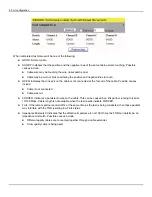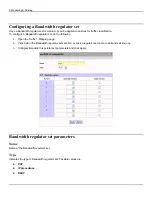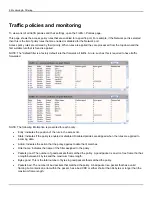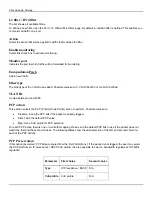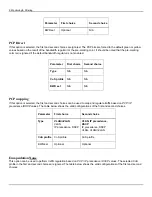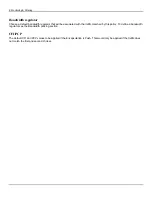
5: Monitoring & Filtering
•
The Accedian replacement: 01:15:AD:CC:xx:yy MAC is used. Because this replacement MAC has variable
elements, it can be used on multiple rules as the variable elements allow a match to a specific rule when a
tunneled frame ingresses the network port. These variable elements are set as such:
z
xx: the unique ID specified in the configuration (see below). When creating a tunnel between two units, this is
used to match the replacement frames going both ways on the network port. As such, it is important that the
matching rules on both endpoints have the same unique ID.
z
yy: the protocol ID. This is automatically generated according to which Layer-2 control protocol the rule
handles.
Operation mode
This controls how the rule will handle the traffic associated with the specified protocol. Four modes of operation are
available:
•
Drop: frames matching the specific rule are dropped.
•
Forwarding: frames are sent unaltered from the incoming to the outgoing port. Optionally, EVC mapping can be
enabled on forwarding rules (see below).
•
Tunneling: frames matching the specific rule get their destination MAC address replaced by the MAC specified in
the rule's parameters when ingressing the specified client port. Frames matching the specific rule get their original
destination MAC address put back when ingressing the specified network port.
•
Peering: the frames are sent to software layers for further processing.
Incoming port
This allows the incoming port used by the rule to be selected. The incoming port is considered to be the port where the
layer-2 control protocols will ingress.
Outgoing port
This allows the outgoing port used by the rule to be selected. The outgoing port is considered to be the port where the
tunneled frames, containing a replacement destination MAC, will egress.
EVC Mapping
This allows the forwarding rules to perform VLAN tagging on the forwarded frames. Possible values are:
None:
frames matching the specific rule are forwarded unmodified.
Push:
frames matching the specific rule are forwarded with an extra VLAN tag determined by the VLAN ID field and their
Ethernet type is set to the value specified by the VLAN ethertype field.
Pop
: frames matching the specific rule and where the VLAN tag matches the VLAN ID field and the Ethernet type
matches the value specified by the VLAN ethertype field are forwarded, with the VLAN tag stripped. If the frame's
VLAN ID or ethertype does not match, it is dropped.
Unique ID
This is used to uniquely identify a rule when performing tunneling. As described in the Replacement MAC section above,
this value is used when building the replacement destination MAC address. Note that the same value has to be used on
both sides when creating a tunnel-detunnel set of rules between a pair of units.
VLAN ethertype
Allows selecting the ethertype of the tag inserted in the forwarded frame. This is available only when the Forwarding
operation mode is selected.
Summary of Contents for EtherNID EE
Page 8: ...8 Alarms 199 1 APPENDIX B MIB SUPPORT 203 Public MIBs 203 Private MIBs 205...
Page 71: ...4 Port configuration...
Page 121: ...6 Alarms Alarm configuration The Alarm Configuration page lists all defined alarms...
Page 164: ...9 Performance Assurance Agent 3 Configure parameters and click Apply...
Page 191: ...11 CFM 10 Open the CFM DMM Configuration and select add...





